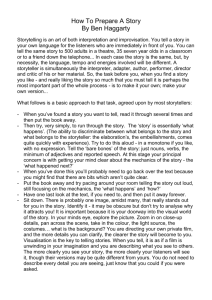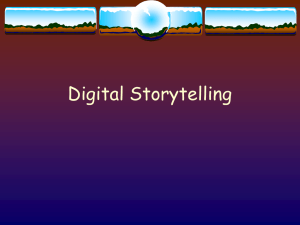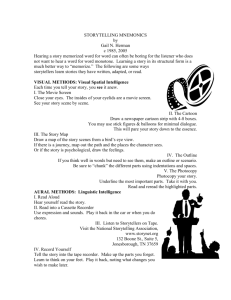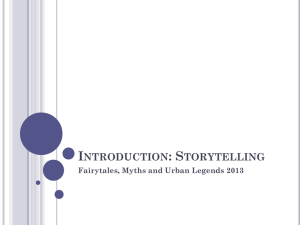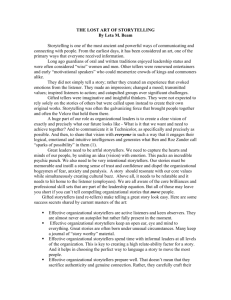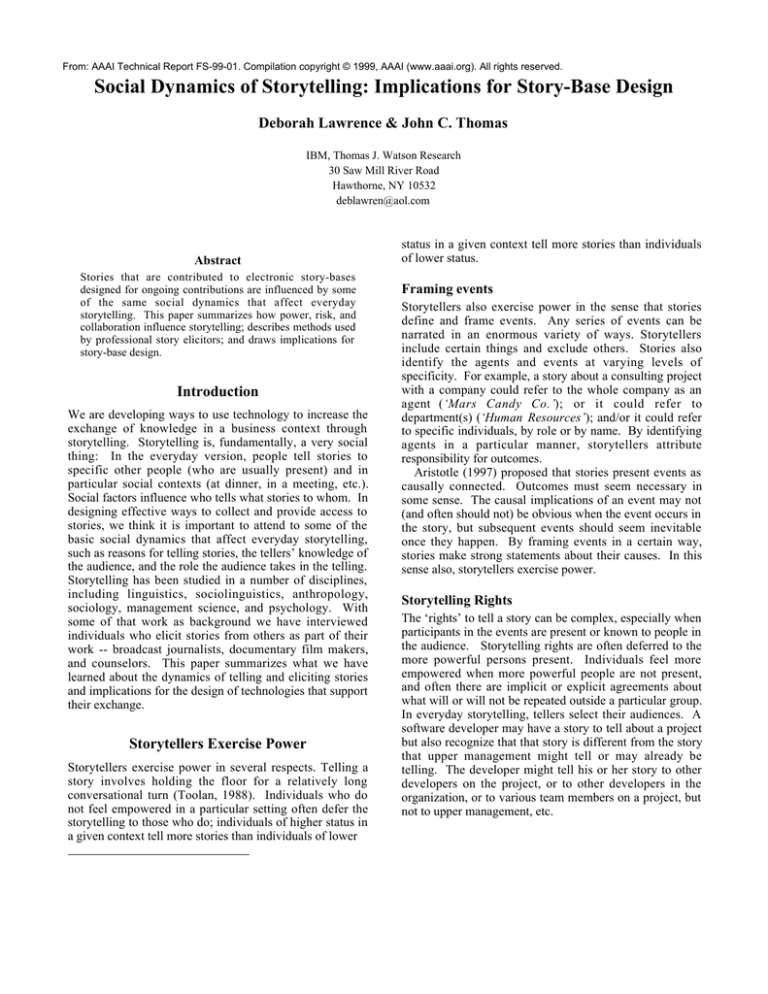
From: AAAI Technical Report FS-99-01. Compilation copyright © 1999, AAAI (www.aaai.org). All rights reserved.
Social Dynamics of Storytelling: Implications for Story-Base Design
Deborah Lawrence & John C. Thomas
IBM, Thomas J. Watson Research
30 Saw Mill River Road
Hawthorne, NY 10532
deblawren@aol.com
Abstract
Stories that are contributed to electronic story-bases
designed for ongoing contributions are influenced by some
of the same social dynamics that affect everyday
storytelling. This paper summarizes how power, risk, and
collaboration influence storytelling; describes methods used
by professional story elicitors; and draws implications for
story-base design.
Introduction
We are developing ways to use technology to increase the
exchange of knowledge in a business context through
storytelling. Storytelling is, fundamentally, a very social
thing: In the everyday version, people tell stories to
specific other people (who are usually present) and in
particular social contexts (at dinner, in a meeting, etc.).
Social factors influence who tells what stories to whom. In
designing effective ways to collect and provide access to
stories, we think it is important to attend to some of the
basic social dynamics that affect everyday storytelling,
such as reasons for telling stories, the tellers’ knowledge of
the audience, and the role the audience takes in the telling.
Storytelling has been studied in a number of disciplines,
including linguistics, sociolinguistics, anthropology,
sociology, management science, and psychology. With
some of that work as background we have interviewed
individuals who elicit stories from others as part of their
work -- broadcast journalists, documentary film makers,
and counselors. This paper summarizes what we have
learned about the dynamics of telling and eliciting stories
and implications for the design of technologies that support
their exchange.
Storytellers Exercise Power
Storytellers exercise power in several respects. Telling a
story involves holding the floor for a relatively long
conversational turn (Toolan, 1988). Individuals who do
not feel empowered in a particular setting often defer the
storytelling to those who do; individuals of higher status in
a given context tell more stories than individuals of lower
status in a given context tell more stories than individuals
of lower status.
Framing events
Storytellers also exercise power in the sense that stories
define and frame events. Any series of events can be
narrated in an enormous variety of ways. Storytellers
include certain things and exclude others. Stories also
identify the agents and events at varying levels of
specificity. For example, a story about a consulting project
with a company could refer to the whole company as an
agent (‘Mars Candy Co.’); or it could refer to
department(s) (‘Human Resources’); and/or it could refer
to specific individuals, by role or by name. By identifying
agents in a particular manner, storytellers attribute
responsibility for outcomes.
Aristotle (1997) proposed that stories present events as
causally connected. Outcomes must seem necessary in
some sense. The causal implications of an event may not
(and often should not) be obvious when the event occurs in
the story, but subsequent events should seem inevitable
once they happen. By framing events in a certain way,
stories make strong statements about their causes. In this
sense also, storytellers exercise power.
Storytelling Rights
The ‘rights’ to tell a story can be complex, especially when
participants in the events are present or known to people in
the audience. Storytelling rights are often deferred to the
more powerful persons present. Individuals feel more
empowered when more powerful people are not present,
and often there are implicit or explicit agreements about
what will or will not be repeated outside a particular group.
In everyday storytelling, tellers select their audiences. A
software developer may have a story to tell about a project
but also recognize that that story is different from the story
that upper management might tell or may already be
telling. The developer might tell his or her story to other
developers on the project, or to other developers in the
organization, or to various team members on a project, but
not to upper management, etc.
Implications for Story-Bases
Story-bases that attempt to increase the exchange of
knowledge through stories need to attend to the fact that
not all individuals feel equally empowered to tell stories.
Methods for eliciting stories may have to overcome the
natural reluctance of many individuals to act as storytellers;
the role may seem incommensurate with many people’s
own perceived power and status.
Story-bases that attempt to increase the exchange of
knowledge through stories need to attend to the fact that
not all individuals feel equally empowered to tell stories.
Methods for eliciting stories may have to overcome the
natural reluctance of many individuals to act as storytellers;
the role may seem incommensurate with many people’s
own perceived power and status.
Human story elicitors, such as interviewers for mass
media and counselors, can be very effective in getting rich,
informative stories. Typically, their interviewees have
knowledge of events that are of interest to others. Often,
however, they have not framed the events as a story per se.
In addition, they may not consider what they know to be of
interest or value to others. Before getting a story, elicitors
attempt to establish both the value of the person’s
knowledge and good reasons for communicating it. They
often begin by asking general questions about the person’s
experience and showing interest in their answers. They
attempt to in effect demonstrate the extent and value of the
person’s own knowledge.
Elicitors also recognize that storytellers need a reason to
tell a story. If they do not already have one, elicitors try to
provide one. In some cases, interviewees are persuaded to
tell a story because the journalist ‘needs it by five o’clock’;
in other cases, interviewees might be motivated to help
others in similar situations. In any event, before eliciting a
story, elicitors make sure that the person has an adequate
reason to tell it.
When stories are solicited for a story-base, providing a
human elicitor for at least some stories can expand the
breath and depth of the corpus. Tellers tend to relate more
story-enlivening detail when they have an elicitor as a live,
and interested, audience. Elicitors can also encourage
contributions by simply relieving tellers of some of the
work of preparing stories for the story-base. It also makes
sense for story-bases in organizations to allow tellers to
flexibly determine what group or groups have access their
stories.
Storytelling Involves Risk
Storytellers take a risk in that a story may not be accepted
as relevant or newsworthy. When relating a story, the
teller makes the audience an implicit promise that there
will be some pay-off; they will be entertained, amused,
amazed, or enlightened, etc. If the story is not sufficiently
compelling, the response may be ‘So what?’ or ‘What’s the
point?’ (Labov & Fanschel, 1977; Polanyi, 1979). In
group settings, storytellers limit their risk by deferring to
the more powerful individuals present, who have greater
protection from potential loss of face. Labov notes that
storytellers also often limit their risk by including an
explicit ‘evaluation’ within the story, i.e., a comment
illustrating how the story is notable or newsworthy (e.g., ‘I
finally understood what he’d been saying all along,’ or,
‘I’ll never do THAT again.’). Storytellers also temper risk
by attempting to elicit group endorsement of a story they
propose to tell, before launching into the story ( ‘Did you
hear what happened to Oscar?’) (Labov & Waletzsky,
1967; Toolan, 1988).
Implications for Story-Bases
If stories are not elicited in a group context, tellers must
judge the relevance and noteworthiness of a story in a
semi-vacuum. What’s sufficiently interesting, important,
etc., to warrant a story? Who wants/needs to know? There
can be a reluctance to speak in the absence of social cues
from the target group. Story-bases can provide some of the
same ways of moderating risk that individuals use in
conversation. An approach we have used is to derive
topics from interviews, have group members rate the value
of those topics, and then request stories on the more valued
topics. The teller has advance buy-in, which reduces the
need for immediate audience feedback.
Storytelling is Often Collaborative
Often, stories are not monologues; multiple people jump in
with additions, questions, corrections, comments, protests,
etc. (Blum-Kulka, 1993; Norrick, 1997; Ochs, Taylor,
Rudolph, & Smith, 1992; Sacks, 1974). Group storytelling
can be a collective activity of sense-building, with various
individuals contributing their own recollections and
interpretations (Boje, 1991; Ochs et al, 1992; Sacks, 1974).
Though collective sense-building is constructive for the
group, collaborative contributions are not always
appreciated by the person who initiated the telling (‘Who’s
telling this story anyway?’). Differing points of view are
often in effect challenges to the other storyteller(s).
Implications for Story-Bases
Group sense-building is a valuable function of storytelling,
and electronic story-bases can simulate it by providing
facilities for comments, re-tellings, etc. But even in faceto-face communication, ‘collaborative’ contributions are
often disquieting. In electronic communication, where
social cues are reduced, group storytelling becomes even
more delicate, and respect and etiquette are important.
People use Stories to Enhance Face
Individuals’ presentation of self is enhanced when others
endorse the line they present by accepting and positively
evaluating their stories (Goffman, 1981). Related to face
enhancement is Schank’s notion of me-goals (Schank,
1990). People often tell stories to demonstrate something
they want to say about themselves (e.g., ‘I’m funny’).
Unfortunately, some of the most interesting and useful
stories in business and other contexts are about mistakes.
But telling stories about one’s own mistakes runs the risk
of loss of face. Mistake stories can also be face-enhancing,
of course, if the storyteller implies that they learned
something, or if they managed to make things turn out all
right in the end, or if they are offering their mistake to help
others.
Some mistake stories carry much higher risk than others.
The easier ones to tell are about events that were not
recent, where nothing was really lost, and which involve
mistakes that can be avoided in the future. People often
tell stories about something dumb they did on their first
day on a job, due to a simple lack of information. Higher
risk mistake stories, which might be of even more value to
a group, would be stories involving mistakes that are more
recent, that may have entailed some real cost (such as
losing a customer), and that may be repeated. (Mistakes
such as ‘failing to hear the customer’ can be easily repeated
in ever new ways.) Higher risk mistake stories may be of
particular value, since they deal with the real difficulties of
an endeavor.
Implications for Story-Bases
One way to encourage mistake stories in a story-base is
through modeling. If respected persons provide high risk
mistake stories, others might be encouraged to do so. In a
story-base designed for ongoing contributions, the initial
seed stories can be a powerful influence on the stories
subsequently contributed.
Be a great audience. Elicitors listen closely and focus
intensely on the teller. They report that they elicit more
authentic stories when they as audience are receptive and
fully comprehending. They attempt to establish a strong
one-to-one connection between themselves and the teller;
some described an almost hypnotic bond that is temporarily
created. Broadcast journalists must often elicit stories
while other people, such as camera crews, are present. If
the interviewee is distracted (e.g., by coughing from the
crew), the one-to-one connection can be broken, and the
story becomes more generic and less genuine.
Don’t resist the story. Elicitors make it a practice not to
reject what the interviewee offers. If the interviewee gets
into topics that seem irrelevant or unproductive, the elicitor
does not say, ‘No, that’s not what I want’ or even, ‘No,
what I meant was...’ . Rather, they hear out what is offered
and follow up with additional questions.
Observe an implicit contract of trust. There is one
exception to the rule of never rejecting the narrative: If the
interviewer feels at some point that the storyteller is not
telling the truth, they might ‘look askance’ or otherwise
convey that they question what they are hearing. In other
words, they conduct the interview as though there were an
implicit agreement in which the storyteller will share their
knowledge openly and accurately, and the elicitor will
accept it appreciatively. If that agreement is violated , the
procedure must break down.
Conclusions: Summary of Implications for
Story-Base Design
Provide Story Elicitors
Story Elicitor Guidelines
Professional story elicitors deal regularly with the social
dynamics that influence people’s willingness to tell stories
and the kinds of stories they tell. Interviews with story
elicitors in several different fields -- broadcast news,
documentary film-making, and counseling -- found
common guidelines for obtaining informative and
interesting stories:
Warm-up. Elicitors find it important for both themselves
and the storyteller to be relaxed. Before eliciting a story,
they try to establish a comfortable tone. They might say
something about themselves, to establish a sense of
reciprocity and to give the interviewee a sense of the
person they are talking to. The elicitor might chat, talk
about how the interview will be used, answer questions,
etc.
Empower the storyteller. As discussed above in
connection with power, elicitors attempt to empower
interviewees by conveying that the interviewee has
valuable knowledge and giving them an adequate reason to
tell their story.
Human elicitors can increase the breadth and depth of a
story-base. Storytellers tell more interesting stories to a
live audience, and elicitors obtain stories that otherwise
would not be contributed. Since interviewees tend to adapt
their telling to the elicitors’ level of knowledge about the
subject, elicitors’ knowledge should match that of the
intended audience of the story-base as much as possible.
Empower Storytellers
Either human elicitors and/or the story-base itself should
convey respect for contributors’ knowledge and provide
adequate reason for telling stories.
Obtain Advance Buy-in for at Least Some Stories
Pre-endorsement of topics can be obtained in several ways:
Story-bases can provide a facility for users to request
stories on specific topics; requests can be obtained off-line;
story-bases can also allow prospective storytellers to put
out an ‘offer’ for a story on a particular topic and obtain an
indication of audience interest before contributing the
story.
Support a Range of Story Types
Seeding story-bases with various types of stories that can
benefit a group (e.g., mistake stories) can spur others to
contribute related stories. In face-to-face settings, one
story is often followed by another story on the same theme
(Sacks, 1974; Boje, 1991).
Provide for Collaborative Storytelling
Simply grouping stories on a particular topic partially
simulates in-person collaboration. Story-bases can also
provide ways for audiences to comment, discuss, debate,
build combined stories, etc. Because of the potential
volatility of electronic communications, standards of
courtesy are important. An organizational story-base might
benefit from having a human librarian who can not only
monitor ethical standards but also set a tone of respect that
contributors can emulate.
References
Aristotle,
Penguin.
ed. 1997. Poetics. M. Heath, translator.
Blum-Kulka, S., 1993. You gotta know how to tell a story:
Telling, tales, and tellers in American And Israeli narrative
events at dinner. Language in Society, 22, 361-402.
Boje, D., 1995. Stories of the storytelling organization: A
postmodern analysis of Disney as “Tamara Land”.
Academy of Management Journal, 38: 997-1035.
Boje, D., 1991. The storytelling organization: A study of
story performance in an office supply firm. Administrative
Science Quarterly, 36: 106-126.
Goffman, E., 1981. Forms of Talk.
Pennsylvania Press: Philadelphia.
University of
Labov, W. & Fanschel, D., 1977. Therapeutic Discourse.
New York: Academic Press.
Labov, W. & Waletzsky, J., 1967. Narrative Analysis:
Oral version of personal experience. In June Helm, Ed.
Essays on the verbal and visual arts. , 12-44. Seattle,
University of Washington Press.
Norrick, N., 1997. Twice-Told Tales: Collaborative
narration of familiar stories. Language in Society, 26, 199220.
Ochs, E., Taylor, C., Rudolph, D., & Smith, R., 1992.
Storytelling as a theory-building activity. Discourse
Processes, 15, 32-72
Polanyi, L., 1979. So what’s the point? Semiotica, 25, 20741.
Sacks, H., 1974. An analysis of the course of a joke’s
telling. In Richard Bauman & Joel Sherzer (eds.)
Explorations in the ethology of speaking, 337-353.
Cambridge University Press: Cambridge.
Schank, R., 1990. Tell me a story: Narrative and
intelligence. Northwestern University Press: Evanston.
Toolan, M., 1988. Narrative: A critical linguistic
introduction. Routledge: New York.

